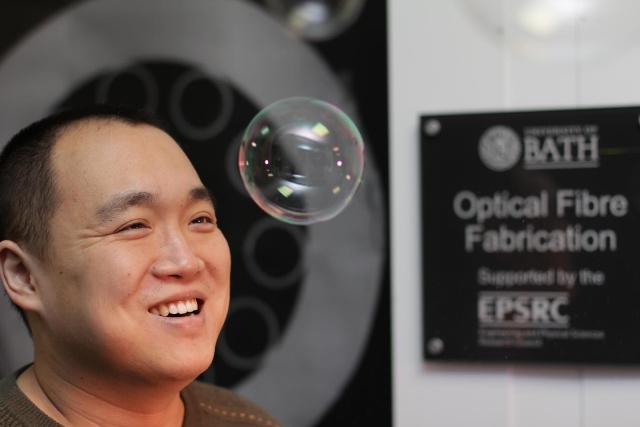Feb 26 2016
Researchers at the University of Bath, United Kingdom have created a new kind of laser capable of pulsed and continuous mid-infrared (IR) emission between 3.1 and 3.2 microns, a spectral range that has long presented a major challenge for laser developers.
 The fiber's long and thin bubbles of glass reflect light into the fiber's core much in the same way that light reflects off the surface of the soap bubble in the foreground, making it appear iridescent.Credit: University of Bath
The fiber's long and thin bubbles of glass reflect light into the fiber's core much in the same way that light reflects off the surface of the soap bubble in the foreground, making it appear iridescent.Credit: University of Bath
The achievement could aid in the development of new uses for mid-IR lasers, which are currently used in applications such as spectroscopy, environmental sensing and detecting explosives.
The new laser, detailed in The Optical Society's high impact journal Optica, combines aspects of both gas and fiber lasers. Fiber lasers are useful because they tend to be stable and easy to use, produce high quality beams, can emit at high powers, and are easy to cool. Placing a suitable gas inside of a hollow optical fiber allowed the researchers to create a fiber gas laser with mid-IR emission. Lasers are central to thousands of consumer, industrial and scientific products; the uses for each type of laser depend on factors such as power, beam quality and wavelength.
"Beyond about 2.8 microns, conventional fiber lasers start to fall off in terms of power, and the other main technology for the mid IR, quantum cascade lasers, doesn't pick up until beyond 3.5 microns," said William Wadsworth, who co-led the research team with Jonathan Knight, also at the University of Bath. "This has left a gap that has presented a great deal of difficulty."
New hollow-core fibers
Key to the laser's success was the team's development of silica hollow-core fibers that perform exceptionally well in the mid-IR. Hollow-core fibers are a new class of fibers that use internal glass structures to confine light inside hollow cores, whereas traditional optical fibers confine light in a solid core of glass.
"You can think of the structures in our fibers as very long and thin bubbles of glass," explained Wadsworth. "By surrounding the region of space in the middle of the fiber with the bubbles, light that is reflected by the bubbles will be trapped inside of the hollow core."
Because light traveling inside a hollow-core fiber remains mostly in the empty core, these fibers overcome the tendency of silica-based glass to absorb light at wavelengths past 2.8 microns. Silica is the preferred material for optical fibers because it inexpensive, easy to manufacture and extremely strong.
Creating a laser
The researchers recognized that their new hollow core fibers could enable a new type of fiber laser. Lasers require an electrical current or another laser to excite a material's electrons, which then emit photons as they return to their normal state. The researchers used acetylene gas because it emits in the mid-IR and can be excited, or pumped, using lasers designed for the telecommunications industry. The hollow-core fibers provided a way to trap the light and the gas in the same place so that they can interact for a very long distance -- 10 or 11 meters in this case.
The University of Bath researchers as well as other research groups have previously shown that gas inside a fiber can interact with light to produce mid-IR emission. In the new work, the researchers added a feedback fiber, the last component needed to consider the device a true laser. The feedback fiber takes a small amount of light produced in the fiber containing the acetylene gas and uses that light to seed another cycle of light amplification, thus reducing the pump power required to produce a laser beam.
One important advantage of the new design is its use of mature telecommunications diode lasers, which are practical, inexpensive, and available in high powers. The researchers plan to use a higher power pump laser to increase the fiber gas laser's power.
Future expansion
"We developed a way to use light to pump molecules and generate light that is not that common to see in a laser system," said Fei Yu, a member of the research team. "This new way to construct a gas laser could be expanded to make more and more laser types that would have been impossible without our hollow-core fiber."
The researchers say that a number of other gases should work with their fiber gas laser, allowing emission up to 5 microns. "This laser is just one use of our hollow-core fiber," said Muhammad Rosdi Abu Hassan, a doctoral student and first author of the paper. "We see it stimulating other applications of the hollow fiber and new ways of interacting different types of laser beams with gases at various wavelengths, including wavelengths that you wouldn't expect to work."